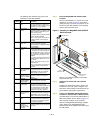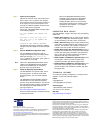
PN: 80-00112-01 Rev. A
DB11-000072-01, Version 2.0, February 2006
Find a list of LSI Logic Corporation’s U.S. distributors, international distributors,
sales offices, and design resource centers on the LSI Logic web site at:
http://www.lsilogic.com/contacts/index.html
LSI Logic, theLSI Logic logo design,and MegaRAID are registeredtrademarks of
LSI Logic Corporation. All other brand and product names may be trademarks of
their respective companies.
®
Copyright © 2005-2006 by LSI Logic Corporation. All rights reserved.
LSI Logic products are not intended for use in life-support appliances, devices, or
systems.Use ofanyLSILogicproduct insuchapplications withoutwritten consent
of the appropriate LSI Logic officer is prohibited.
Purchase of I
2
C components of LSI Logic Corporation, or one of its sublicensed
Associated Companies, conveys a license under the Philips I
2
C Patent Rights to
use these componentsin anI
2
C system, provided that thesystem conforms tothe
I
2
C standard Specification as defined by Philips.
LSI Logic Corporation reserves the right to make changes to any products and
services herein at any time without notice. LSI Logic does not assume any
responsibility or liability arising out of the application or use of any product or
service described herein, except as expressly agreed to in writing by LSI Logic;
nor doesthe purchase, lease,oruse ofa productor service fromLSILogic convey
a license under any patent rights, copyrights, trademark rights, or any other of the
intellectual property rights of LSI Logic or of third parties.
Step 7 Power-Up the Computer
Replace the computer cover and reconnect the
power cord(s). Turn on power to the computer.
Ensure that the devices are powered up before or
at the same time as the host computer. If the
computer is powered up before the devices, the
devices might not be recognized.
During boot, a MegaRAID BIOS message similar
to the following displays:
LSI LOGIC MEGARAID BIOS VERSION xxxx
[date]
Copyright (c) 2005, LSI Logic Corp.
HA-1 (Bus x Dev y) LSI MegaRAID SAS
8344ELP PCI-E
Standard FW xxxx DRAM=xxx MB(SDRAM)
The firmware takes several seconds to initialize.
During this time the adapter scans the Serial ATA
ports.
Step 8 Run the WebBIOS Configuration Utility
Run the WebBIOS Configuration Utility to
configure the physical arrays and logical drives.
When the message Press <Ctrl><H> for
WebBIOS displays on the screen, press CTRL+H
immediately to run the utility.
Note: Refer to the MegaRAID SAS Software User’s
Guide on the MegaRAID Universal Software
Suite CD for detailed steps on configuring
physical arrays and logical drives.
Step 9 Install the Operating System Driver
The SAS 8344ELP can operate under various
operating systems. To operate under these
operating systems, you must install software
drivers.
The MegaRAID Universal Software Suite CD
includes drivers for the supported operating
systems, along with documentation. You can view
the supported operating systems and download
the latest drivers for RAID adapters on the
LSI Logic web site at:
http://www.lsilogic.com/downloads/main.do.
Access the download center and follow the steps
to download the driver.
Refer to the MegaRAID SAS Device Driver
Installation User’s Guide on the MegaRAID
Universal Software Suite CD for details on
installing the driver. Be sure to use the latest
Service Packs provided by the operating system
manufacturer and review the readme file that
accompanies the driver.
SUPPORTED RAID LEVELS
The SAS 8344ELP supports disk arrays using the following
RAID levels:
• RAID 0 (Data striping): Data is striped across all disks
in the array, enabling very fast data throughput. There is
no data redundancy. All data is lost if any disk fails.
• RAID 1 (Disk mirroring): Data is written simultaneously
to two disks, providing complete data redundancy if one
disk fails. The maximum array capacity is equal to the
available size of the smaller of the two hard drives.
• RAID 5 (Disk striping with distributed parity): Data is
striped across all disks in the array. Part of the capacity
of each disk stores parity information that reconstructs
data if a disk fails. Provides good data throughput for
applications with high read request rates.
• RAID 10 (RAID 1 and RAID 0 in spanned arrays): Uses
mirrored pairs of disks to provide complete data
redundancy. Provides high data throughput rates.
• RAID 50 (RAID 5 and RAID 0 in spanned arrays): Uses
both parity and disk striping across multiple disks to
provide complete data redundancy. Provides high data
throughput rates.
TECHNICAL SUPPORT
For assistance installing, configuring, or running the SAS
8344ELP, contact LSI Technical Support:
E-mail:
support@lsil.com
eurosupport@lsil.com (Europe)
Phone Support:
1-800-633-4545 (North America)
+44 1344 413 441 (Europe)
Web Site:
http://www.lsilogic.com/support/





